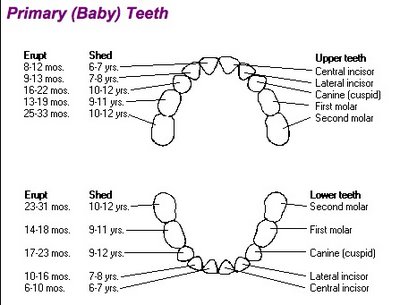They are just baby teeth, why fix them?
Most babies get their first tooth around 6 or 7 months of age; usually the bottom front two incisors. Some kids are a little slower erupting the first tooth causing parental worry. It can be even around 12 months for the first one to poke through. Additional baby teeth will continue to come in till almost three years of age. There really is a lot of variability on the sequence. Don’t feel bad if your child does not get his teeth just like your neighbor’s baby or even his own twin sister. This is important: look at the chart below and you will see that some baby teeth START falling out around 5-6 years old (again give or take a little), but the back molars do not fall out till around 12 years of age!
If your child develops a cavity in a baby tooth the decay will slowly (and sometimes rapidly) get bigger and deeper. If the tooth is really close to falling out, we have the option of just leaving it alone. If it looks like it may be a while till it would normally fall out, we need to do something. Otherwise you are in for ugly teeth, toothaches, infection and more extensive dental work.
A small cavity can be filled with a white filling, a medium cavity can be filled, but a deep or large cavity may need a crown to cover the whole tooth. If the tooth is in the back, the crown may be silver in color. It may even need a Pulpotomy or “nerve treatment”. So, get it fixed early when it is small (and less expensive)!
Remember baby teeth are there for a reason. They give the child something to chew with and (importantly) they often save space for the permanent teeth. Why don't you just pull it? Well, sometimes that is the best option, but if a back baby tooth is lost too early, without followup treatment, additional crowding problems that are often more difficult to correct will occur. So you usually will need additional work like a Space Maintainer. That's one reason why it's often easier to fix a baby tooth than just remove it.
Here is an ADA eruption chart for general reference:

Most babies get their first tooth around 6 or 7 months of age; usually the bottom front two incisors. Some kids are a little slower erupting the first tooth causing parental worry. It can be even around 12 months for the first one to poke through. Additional baby teeth will continue to come in till almost three years of age. There really is a lot of variability on the sequence. Don’t feel bad if your child does not get his teeth just like your neighbor’s baby or even his own twin sister. This is important: look at the chart below and you will see that some baby teeth START falling out around 5-6 years old (again give or take a little), but the back molars do not fall out till around 12 years of age!
If your child develops a cavity in a baby tooth the decay will slowly (and sometimes rapidly) get bigger and deeper. If the tooth is really close to falling out, we have the option of just leaving it alone. If it looks like it may be a while till it would normally fall out, we need to do something. Otherwise you are in for ugly teeth, toothaches, infection and more extensive dental work.
A small cavity can be filled with a white filling, a medium cavity can be filled, but a deep or large cavity may need a crown to cover the whole tooth. If the tooth is in the back, the crown may be silver in color. It may even need a Pulpotomy or “nerve treatment”. So, get it fixed early when it is small (and less expensive)!
Remember baby teeth are there for a reason. They give the child something to chew with and (importantly) they often save space for the permanent teeth. Why don't you just pull it? Well, sometimes that is the best option, but if a back baby tooth is lost too early, without followup treatment, additional crowding problems that are often more difficult to correct will occur. So you usually will need additional work like a Space Maintainer. That's one reason why it's often easier to fix a baby tooth than just remove it.
Here is an ADA eruption chart for general reference:

Comments
Post a Comment